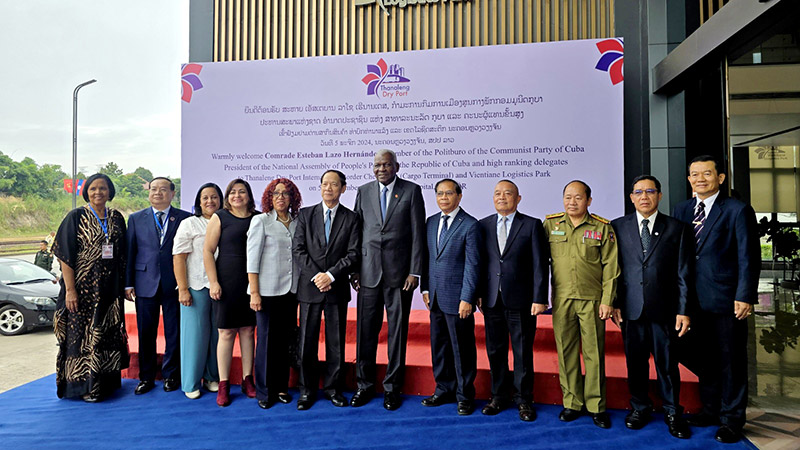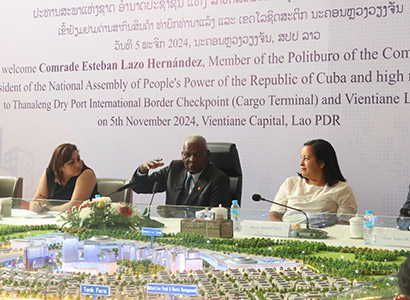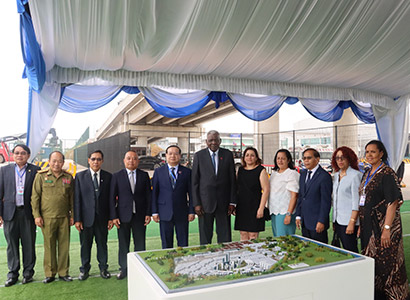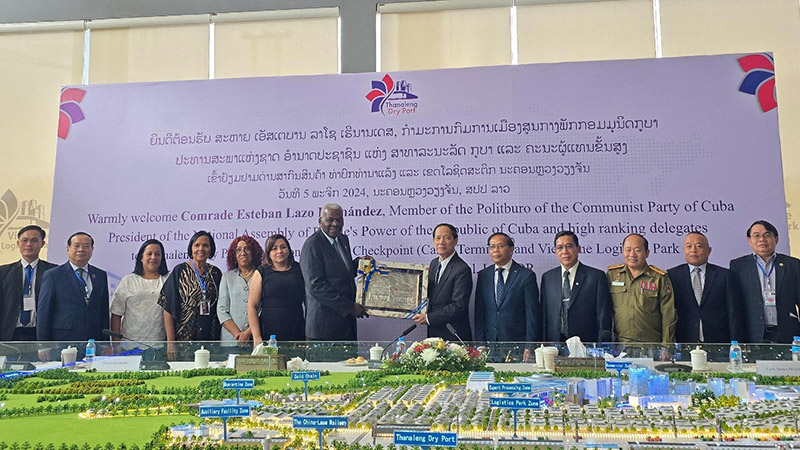Thanaleng Dry Port ‘a boon for regional trade’, top Cuban legislative official told
President of the National Assembly of People’s Power of Cuba, Esteban Lazo Hernandez, led a high-level delegation for an official visit to Laos on November 3-6 to forge closer ties.
As part of his visit, the legislative chief of the North American country toured the Thanaleng Dry Port in Vientiane on Tuesday and learned how this integrated logistics centre has significantly bolstered the government’s efforts to turn landlocked Laos into land-linked.
Welcoming Mr Hernandez, former Minister to the Prime Minister’s Office and current President of the Executive Board of Strategy and Planning at PTL Holding Company Limited, the Lao developer of the project, Mr Alounkeo Kittikhoun, highlighted that the dry port and rail network has complimented each other well and add value to services.
 |
As a location where the standard-gauge Laos-China railway and one-metre-gauge Laos-Thailand railway converge, the dry port has enabled a seamless connection of the regional rail network that links the Chinese city of Kunming to Singapore. Through the China-Europe rail network, cargo from Singapore could even reach Europe.
“We are the last jigsaw between Singapore and Germany, which means rail transport can be done between Singapore and Germany,” the Dry Port’s Managing Director, Mr Sakhone Philangam, told the guests.
“Rail freight transport from Thailand to Germany has already been made.”
The dry port was opened for service in December 2021 – just one day after the opening of the Laos-China railway. Categorised by a UN agency as a class one dry port, the Thanaleng Dry Port functions as an international border checkpoint for freight and provides single-window customs clearance for cross-border rail transport.
Mr Sakhone emphasised that establishing the dry port aims to cut logistics costs and bolster Laos’ competitiveness so that manufacturers in Laos could compete with their rivals in the region.
Its operation, complemented by rail transport services, has facilitated a connection with and access to the larger markets of China and Central Asia at competitive prices.
“In the northern trade routes, Laos is in a higher competitive position than neighbouring Thailand,” the director said.
He elaborated that cargo shipment from his dry port to the Chinese border takes just six hours, and to Kunming takes just 12 hours. But from Thailand to China, it takes two to four days, depending on the starting points and destinations.
However, rail transport takes a much shorter time compared to other transport modes.
“[Cargo transport] from ASEAN member countries to Europe takes just somewhere between 14-16 days,” Mr Sakhone said. This is much shorter than the sea route that takes about 45 days from Southeast Asia to Europe.
 |
 |
As the pan-Asia rail network takes shape and connects to the China-Europe rail network, the route runs further to Kazakhstan, Russia, Belarus, and Poland before reaching Duisburg in Germany.
“Countries along the route can make trade [by rail],” Mr Sakhone said.
In 2023, the volume of freight transported on the Laos-China Railway rose to 4.089 million tonnes, a year-on-year increase of 83.1 percent, according to the Laos-China Railway company.
To forge closer links, Mr Sakhone said he has been to many countries along the route and secured partnership agreements, vowing to boost transport cooperation and trade.
Mr Alounkeo said the dry port and its associated Vientiane Logistics Park are part of the broader national logistics system.
“The Lao government has wanted to establish the national logistics system to drive and expedite socio-economic development. The Thanaleng Dry Port and the logistics park are part of the system,” he said.
To leverage the improved logistics link and its cost-effective service, the Lao investor is developing industrial zones through the Vientiane Logistics Park to attract investment and boost trade.
The US$547 million project includes a plant and animal quarantine facility, a tank farm, an export processing zone, a logistics park, a free trade zone, a technology hub, and a gold extraction and processing plant.
Development of these zones is expected to be completed in the next few years, and once they are operational, Mr Alounkeo believes they will become an important driver of the Lao economy.
ByAdvertorial Desk
(Latest Update November 6, 2024)
|





